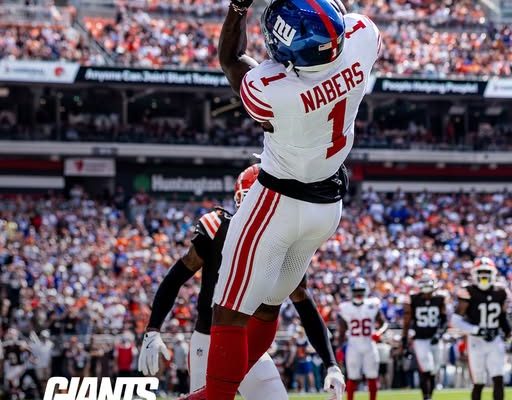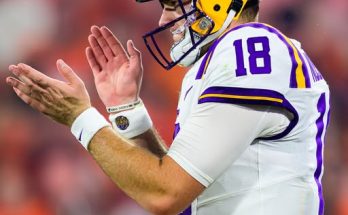The NFL is a league where reputation is earned on the field and respect is validated by performance, production, and perception. Every year, the best players at each position are ranked through various media outlets, and ESPN’s annual positional rankings, based on anonymous surveys with league executives, scouts, and coaches, carry significant weight. This year, one name has sparked both admiration and discussion: Malik Nabers. The former LSU star and current New York Giants wide receiver has been voted among the NFL’s top wide receivers in ESPN’s latest poll, despite having never played a down in a regular season NFL game. To say that this recognition is rare would be an understatement. For a rookie to receive such early acclaim, it suggests not only incredible college tape but also a wave of confidence from insiders who have seen enough to believe that greatness is not a matter of “if” but “when.”
Malik Nabers being named among the league’s best wide receivers before even stepping onto the field for Week 1 is not merely hype—it’s a culmination of elite traits, a powerful collegiate resume, and jaw-dropping preseason performances that left scouts in awe. When evaluators from NFL teams cast their votes, they did so not on the basis of potential alone but on the immediate impact they believe he will have in 2025. For context, ESPN’s rankings typically include only proven veterans or rising stars who’ve already played multiple seasons. For a rookie to crack that echelon—especially with a wide receiver class that includes names like Justin Jefferson, Tyreek Hill, Ja’Marr Chase, Amon-Ra St. Brown, and CeeDee Lamb—speaks volumes.
So, who exactly is Malik Nabers, and why has he been voted into such elite company already?
Nabers hails from LSU, which has become a wide receiver factory over the past decade. From Odell Beckham Jr. and Jarvis Landry to Ja’Marr Chase and Justin Jefferson, LSU wideouts have historically transitioned well into the NFL. Malik Nabers is not only the latest in that proud lineage—he might just be the most dynamic since Chase. In his final college season, Nabers caught 89 passes for 1,569 yards and 14 touchdowns. He averaged an astonishing 17.6 yards per reception, regularly blowing the top off defenses and showcasing a deadly combination of burst, tracking ability, and body control. What made him even more unique was his versatility; he wasn’t just a deep threat. He lined up in the slot, out wide, and even motioned into the backfield on occasion. He could win at all three levels—short, intermediate, and deep. And he did so consistently, against SEC competition.
NFL insiders didn’t merely rely on statistics when evaluating Nabers. The tape tells a more complete story. His ability to separate against man coverage is already being discussed in the same breath as Jefferson and Stefon Diggs. His footwork at the line of scrimmage is nuanced and precise. He doesn’t just rely on athleticism—he combines it with timing, leverage, and football IQ. That blend makes him quarterback-friendly, which is critical, especially on a New York Giants team looking for offensive stability. It’s also worth noting that Nabers was dominant despite not playing in a particularly pass-heavy LSU system and without a Heisman-caliber quarterback throwing him the ball. Much like Jefferson, he made himself available, found soft spots in zone coverage, and created yards after the catch with astonishing regularity.
From a scouting standpoint, one of the main reasons Nabers received such a high rating from NFL personnel is his polish. Unlike most rookie wide receivers, he doesn’t need a redshirt year to adjust to NFL speed and schemes. His route tree is advanced. His understanding of defensive rotations is NFL-ready. His release package off the line is textbook. That’s why during offseason OTAs and minicamps, reports coming out of the Giants’ facility suggested that he was already outperforming expectations. Veteran cornerbacks couldn’t stay in front of him in one-on-one drills, and coaches privately noted that his performance was reminiscent of Odell Beckham Jr.’s rookie camp. What makes Nabers different, however, is his consistency. He doesn’t rely on highlight plays to justify his value. He’s dangerous on 3rd-and-4, in the red zone, and on 1st-and-10 play-action rollouts. He simply gets open—and that, in the NFL, is gold.
The ESPN poll that listed Nabers among the NFL’s top wide receivers wasn’t just built on predictions or social media buzz. These rankings are constructed from the insights of over 80 NFL insiders—people who live and breathe football at its highest level. That includes GMs who watched him closely during the pre-draft process, defensive coordinators who have already begun preparing for him in Week 1, and scouts who remember every snap he played at LSU. When they cast votes for wide receivers they fear or admire, the inclusion of Nabers wasn’t symbolic—it was a strategic acknowledgment. He is already being game-planned for. He is already on scouting reports. That alone elevates his standing beyond a typical rookie.
The parallels with Ja’Marr Chase’s rookie season are already being drawn. Chase, too, came into the league with immense hype, and he silenced doubters by posting over 1,400 receiving yards and helping the Cincinnati Bengals reach the Super Bowl. But while Chase had the benefit of reuniting with Joe Burrow and playing in a pass-happy offense, Nabers enters a more difficult situation. The Giants offense has struggled in recent years, and quarterback Daniel Jones has faced questions about his long-term viability. But that’s also why insiders are even more impressed by Nabers’ rise. He’s expected to elevate the offense rather than simply be a part of it. That kind of expectation is typically reserved for players already in the top 10 of their position group.
From a football education standpoint, this situation also sheds light on how NFL evaluation works behind closed doors. The public often views rookies as needing time to adjust, while insiders sometimes see certain players as immediate franchise changers. With wide receivers especially, recent years have shown that elite college production, combined with translatable traits, often leads to instant NFL success. Players like Justin Jefferson, Garrett Wilson, and Puka Nacua all thrived from the start because they were not only athletically gifted but also mentally prepared. Malik Nabers falls into that category. He’s not just fast—he’s deliberate. He’s not just explosive—he’s efficient. And he’s not just talented—he’s obsessed with the craft.
There’s also a cultural element to Nabers’ rise. Wide receiver has become arguably the most glamorous position in football outside of quarterback. The best wideouts are often the face of the franchise, and the position demands both production and personality. Nabers isn’t loud in the traditional sense, but his confidence is palpable. He carries himself like a veteran, not a rookie. He’s studied the greats and models parts of his game after everyone from Antonio Brown to Calvin Ridley. That approach, paired with his relentless work ethic, made him a quick favorite among teammates and coaches in New York. The trust he’s built with his quarterback, offensive coordinator, and position coach has fast-tracked his involvement in the game plan. He’s expected to be WR1 from the jump.
The ESPN ranking also underscores a larger trend in the NFL: rookies can no longer be underestimated. The old days of rookies sitting behind veterans and gradually easing into the spotlight are dwindling. With better training, advanced collegiate schemes, and year-round development, the best college players are entering the league more prepared than ever. Malik Nabers is not an anomaly in that sense, but he might be the most visible proof of the new normal. That’s why his inclusion among the top receivers wasn’t laughed off—it was respected. League insiders are more than willing to bet on players who exhibit elite traits and mature football habits, even before they’ve stepped onto an NFL field.
From a fan’s perspective, this makes the 2025 NFL season even more exciting. Watching Malik Nabers line up against All-Pro cornerbacks and operate as the focal point of the Giants’ offense is going to be must-see television. Whether he explodes for a 1,200-yard season or finds more modest early success, the foundation is clearly there. The players and coaches who see him every day know it. The opponents who study him on film recognize it. And the league executives who voted for him in ESPN’s poll clearly believe that this is not just a flash in the pan—it’s the beginning of a star turn.
For young athletes looking to understand what it takes to reach this level of recognition, Malik Nabers’ journey is a case study. He was highly recruited out of high school but didn’t rest on that. He improved every year at LSU, never plateauing. He attacked each offseason with purpose. He studied not just how to catch footballs, but how to manipulate defenders, how to read coverages, and how to lead by example. His game is built on speed, yes, but also on subtlety—selling routes with his eyes, setting up defenders with tempo changes, and staying mentally sharp on every snap. These are skills that translate.
Ultimately, Malik Nabers’ inclusion in ESPN’s top wide receiver rankings before his rookie season is a reflection of how quickly greatness can be recognized when it’s paired with preparation and opportunity. While he hasn’t yet caught a pass in an official NFL game, the people who know football best believe that it’s only a matter of time before he’s not just among the best, but the best. For now, fans should enjoy the ride and prepare to witness what could be the emergence of the NFL’s next superstar wide receiver. Because if the insiders are right, Malik Nabers is not only ready—he’s coming. And the league won’t be the same once he arrives.



